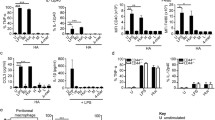Abstract
To investigate human synovial mast cell physiology, we developed a model in which mast cells in human synovial explant cultures were activated by immunologic or non-immunologic mechanisms. Small (3 mm) cubes of synovial membrane were incubated with or without secretagogue for 30, 45 or 60 min, and supernatant histamine concentrations were quantified. We measured significant histamine release with compound 48/80 at concentrations ≥1 mg/ml, and with calcium ionophore A23187 at ≥5 μg/ml. Rabbit IgG anti-human IgE induced significant histamine release at all concentrations tested, maximum at 78 μg/ml. Morphine sulfate produced no histamine release from synovial explants, in contrast to its significant stimulation of histamine release from neonatal foreskin explants in our explant system. We confirmed synovial mast cell degranulation by electron microscopy, and showed that it corresponded with measurable histamine release. Furthermore, histamine release was not due to secretagogue-induced cytotoxicity, as assessed by supernatant lactate dehydrogenase levels and by ultrastructural analysis. Since morphine sulfate induces mast cell degranulation and histamine release in adult and neonatal human skin, our data show that although synovial and dermal mast cells have a similar granule enzyme profile and electron microscopic morphology, they differ in functional responses. These observations support recent data that among similar human mast cell subtypes there are physiologic differences. Finally, our explant model will be useful in studies of mast cell involvement in arthritis.
Similar content being viewed by others
References
Malone DG, Metcalfe DD. Demonstration and characterization of a transient arthritis in rats following sensitization of synovial mast cells with antigen-specific IgE and parenteral challenge with specific antigen. Arthr Rheum 1988;31:1063–7.
Malone DG, Wilder RL, Saavedra Delgado AM, Metcalfe DD. Mast cell numbers in rheumatoid synovial tissues. Correlations with quantitative measures of lymphocytic infiltration and modulation by antiinflammatory therapy. Arthr Rheum 1987;30:130–7.
Malone DG, Irani A, Schwartz LB, Barrett KE, Metcalfe DD. Mast cell numbers and histamine levels in synovial fluids from patients with diverse arthritides. Arthr Rheum 1986; 29:956–63.
Gruber BL, Schwartz LB, Ramamurthy NS, Irani AM, Marchese MJ. Activation of latent rheumatoid synovial collagenase by human mast cell tryptase. J Immunol 1988;140:3936–42.
Kopicky-Burd JA, Kagey-Sabotka A, Peter SP, Dvorak AM, Lennox DW, Lichtenstein LM, et al. Characterization of human synovial mast cells. J Rheumatol 1988;15:1326–33.
Gruber B, Ballan D, Gorevic PD. IgE rheumatoid factors: quantification in synovial fluid and ability to induce synovial mast cell histamine release. Clin Exp Immunol 1988;71:289–94.
Gruber B, Poznansky M, Boss E, Partin J, Gorevic P, Kaplan. Characterization and functional studies of rheumatoid synovial mast cells. Activation by secretagogues, anti-IgE, and a histamine-releasing lymphokine. Arthr Rheum 1986; 29:944–55.
Godfrey HP, Ilardi C, Engber W, Graziano FM. Quantitation of human synovial mast cells in rheumatoid arthritis and other rheumatic diseases. Arthr Rheum 1984;27:852–86.
Crips AJ, Chapman CM, Kirkham SE, Schiller AL, Krane SM. Articular mastocytosis in rheumatoid arthritis. Arthr Rheum 1984;27:845–51.
Wasserman SI. The mast cell and synovial inflammation. Or, what's a nice cell like you doing in a joint like this? Arthr Rheum 1984;27:841–84.
Bromley M, Fisher WD, Woolley DE. Mast cells at sites of cartilage erosion in the rheumatoid joint. Ann Rheum Dis 1984;43:76–9.
Zuraw BL, O'Hair CH, Vaughan JH, Mathison DA, Curd JG, Katz DH. Immunoglobulin E-rheumatoid factor in the serum of patients with rheumatoid arthritis, asthma, and other diseases. J Clin Invest 1981;68:1610–3.
Bridges AJ, Malone DJ, Jicinsky J, Chen M, Ory P, Engber W, et al. Human synovial mast cell involvement in rheumatoid arthritis and osteoarthritis. Arthr Rheum 1991;34,9:1116–24.
Klein LM, Lavker RM, Matis WL, Murphy GR. Degranulation of human mast cells induces an endothelial antigen central to leukocyte adhesion. Proc Natl Acad Sci USA 1989;86:8972–6.
Malone DG, Verbsky JW, Dolan PW. A lavage method for dynamic intraarticular monitoring of animal joints in situ: Quantification and release kinetics of histamine after selective synovial mast cell activation by diverse secretagogues. J Lab Clin Med 1991;188:269–79.
Caulfield JP, el-Lati S, Thomas G, Church MK. Dissociated human foreskin mast cells degranulate in response to anti-IgE and substance P. Lab Invest 1990;63:502–10.
Dvorak AM, Massey W, Warner J, Kissell S, Kagey-Sobotka A, Lichtenstein LM. IgE-mediated anaphylactic degranulation of isolated human skin mast cells. Blood 1991;7:569–78.
Dvorak AM, Kissell S. Granule changes of human skin mast cells characteristic of piecemeal degranulation and associated with recovery during wound healing in situ. J Leukoc Biol 1991;49:197–210.
Hino RH, Lau CKH, Read CW. The site of action of the histamine releaser compound 48/80 in causing mast cell degranulation. J Pharmacol Exp Ther 1977;200:658–63.
Lowman MA, Rees PH, Benyon RC, Church MK. Human mast cell heterogeneity: Histamine release from mast cells dispersed from skin, lung, adenoids, tonsils, and colon in response to IgE-dependent and nonimmunologic stimuli. J Allergy Clin Immunol 1988;81:590–7.
Irani AM, Schechter NM, Craig SS, DeBlois G, Schwartz LB. Two types of human mast cells that have distinct neutral protease compositions. Proc Natl Acad Sci USA 1986;83:4464–8.
Irani AA, Bradford TR, Kepley CL, Schechter NM, Schwartz LB. Detection of MCT and MCTC types of human mast cells by immunohistochemistry using new monoclonal anti-tryptase and anti-chymase antibodies. J Histochem Cytochem 1989;37:1509–15.
Malone DG, Vikingsson A, Seebruch JS, Verbsky JW, Dolan PW. In vivo effects of nonsteroidal antiinflammatory drugs on rat skin and synovial mast cell-induced vasopermeability. Arthr Rheum 1991;34:164–70.
Malone DG, Dolan PW. Droperidol-fentanyl inhibits mast cell histamine release in rat synovium, but not skin, after immunologic activation: Evidence for mast cell heterogeneity. J Allergy Clin Immunol 1990;85:821–7.
Author information
Authors and Affiliations
Additional information
accepted by G. W. Carter
Rights and permissions
About this article
Cite this article
Verbsky, J.W., McAllister, P.K. & Malone, D.G. Mast cell activation in human synovium explants by calcium ionophore A23187, compound 48/80, and rabbit IgG anti-human IgE, but not morphine sulfate. Inflamm Res 45, 35–41 (1996). https://doi.org/10.1007/BF02263503
Received:
Revised:
Accepted:
Issue Date:
DOI: https://doi.org/10.1007/BF02263503




